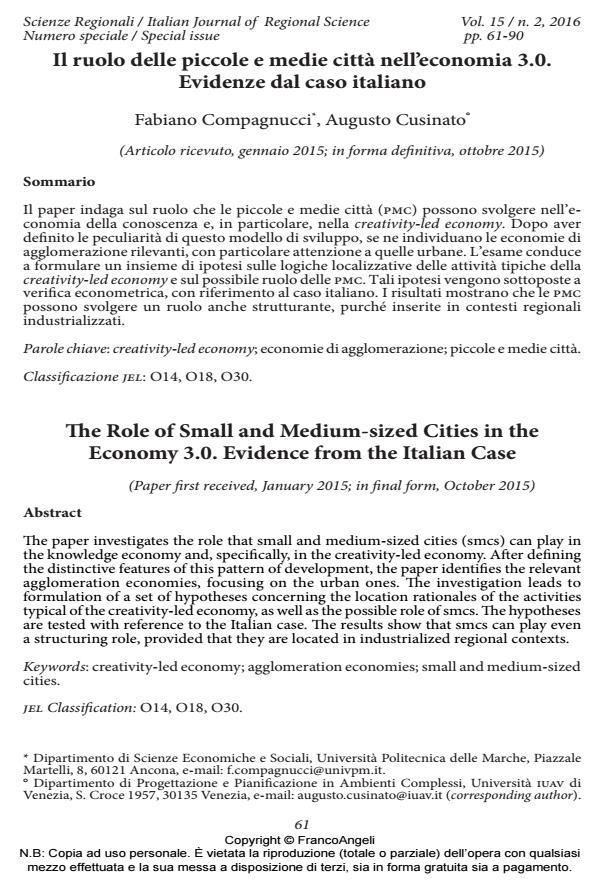Il ruolo delle piccole e medie città nell’economia 3.0. Evidenze dal caso italiano
Titolo Rivista SCIENZE REGIONALI
Autori/Curatori Fabiano Compagnucci, Augusto Cusinato
Anno di pubblicazione 2016 Fascicolo 2016/2
Lingua Italiano Numero pagine 30 P. 61-90 Dimensione file 694 KB
DOI 10.3280/SCRE2016-002004
Il DOI è il codice a barre della proprietà intellettuale: per saperne di più
clicca qui
Qui sotto puoi vedere in anteprima la prima pagina di questo articolo.
Se questo articolo ti interessa, lo puoi acquistare (e scaricare in formato pdf) seguendo le facili indicazioni per acquistare il download credit. Acquista Download Credits per scaricare questo Articolo in formato PDF

FrancoAngeli è membro della Publishers International Linking Association, Inc (PILA)associazione indipendente e non profit per facilitare (attraverso i servizi tecnologici implementati da CrossRef.org) l’accesso degli studiosi ai contenuti digitali nelle pubblicazioni professionali e scientifiche
Il paper indaga sul ruolo che le piccole e medie città (pmc) possono svolgere nell’economia della conoscenza e, in particolare, nella creativity-led economy. Dopo aver definito le peculiarità di questo modello di sviluppo, se ne individuano le economie di agglomerazione rilevanti, con particolare attenzione a quelle urbane. L’esame conduce a formulare un insieme di ipotesi sulle logiche localizzative delle attività tipiche della creativity-led economy e sul possibile ruolo delle pmc. Tali ipotesi vengono sottoposte a verifica econometrica, con riferimento al caso italiano. I risultati mostrano che le pmc possono svolgere un ruolo anche strutturante, purché inserite in contesti regionali industrializzati.
Parole chiave:Creativity-led economy; economie di agglomerazione; piccole e medie città.
Jel codes:O14, O18, O30
- Creativity and local economic development: The role of synergy among different talents Silvia Cerisola, in Papers in Regional Science /2018 pp.199
DOI: 10.1111/pirs.12254 - A comment on Scott and Storper's ‘The nature of cities: The scope and limits of urban theory’ Augusto Cusinato, in Papers in Regional Science /2016 pp.895
DOI: 10.1111/pirs.12259 - Knowledge-creating Milieus in Europe Augusto Cusinato, Andreas Philippopoulos-Mihalopoulos, pp.359 (ISBN:978-3-642-45172-0)
Fabiano Compagnucci, Augusto Cusinato, Il ruolo delle piccole e medie città nell’economia 3.0. Evidenze dal caso italiano in "SCIENZE REGIONALI " 2/2016, pp 61-90, DOI: 10.3280/SCRE2016-002004